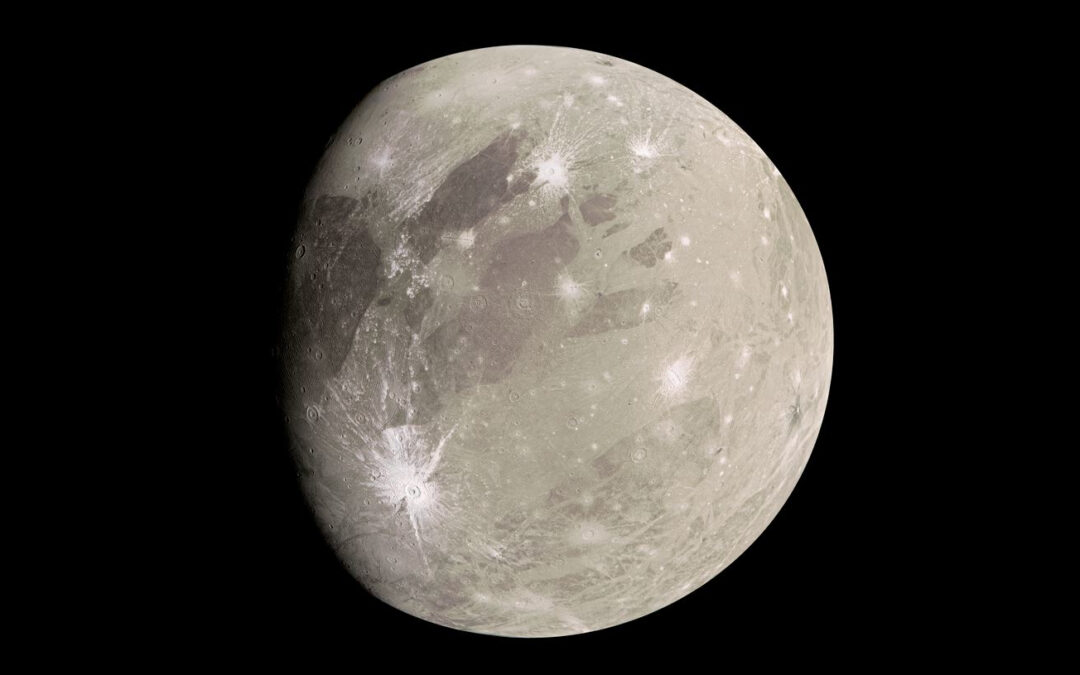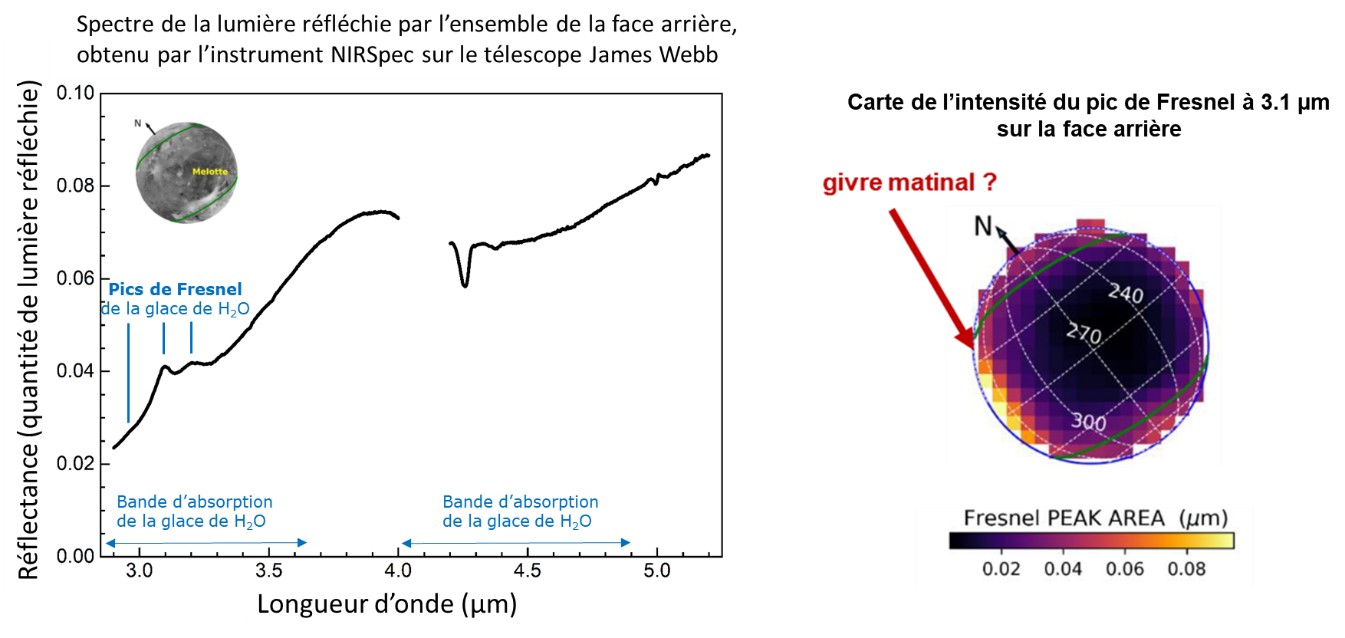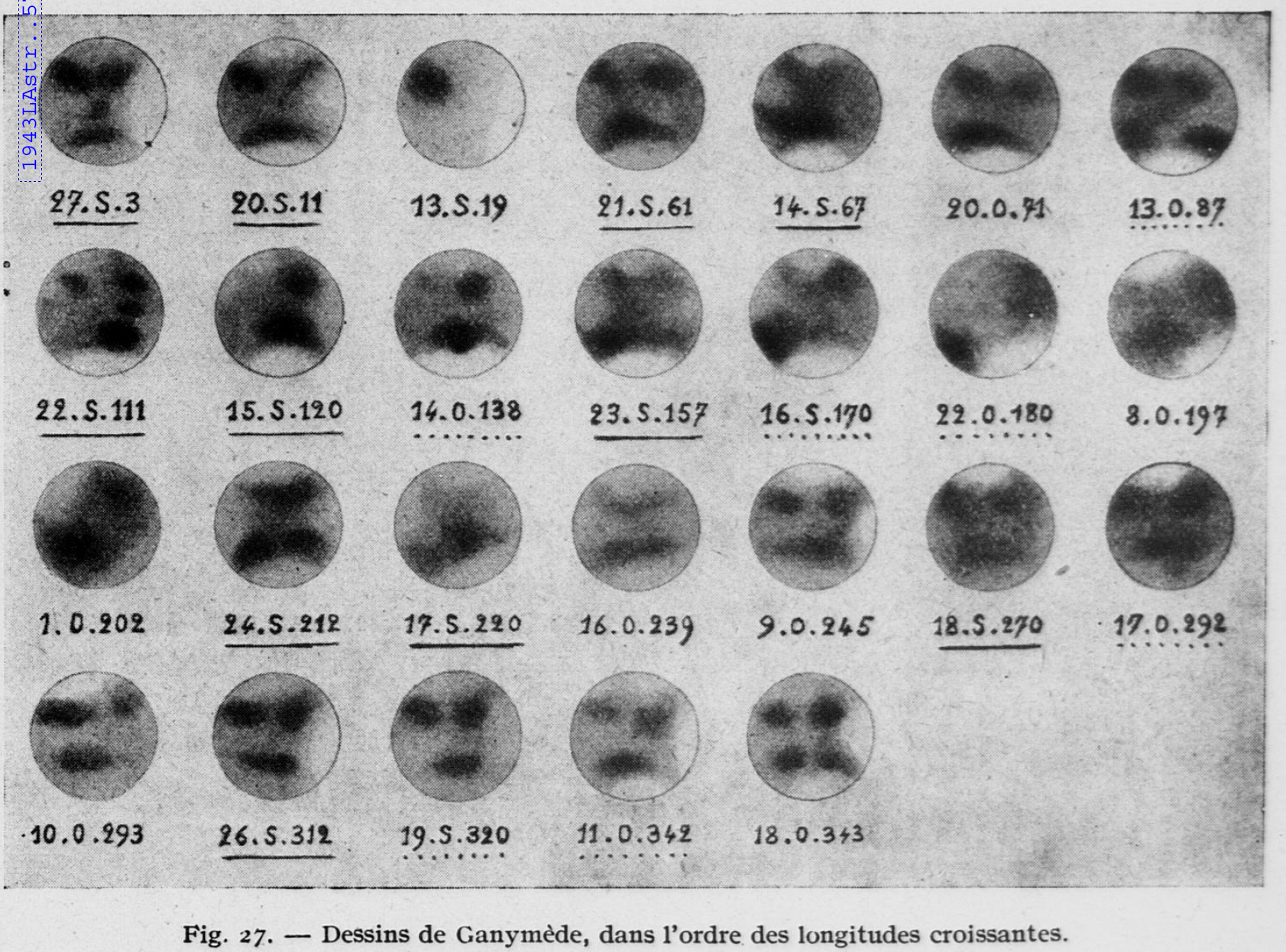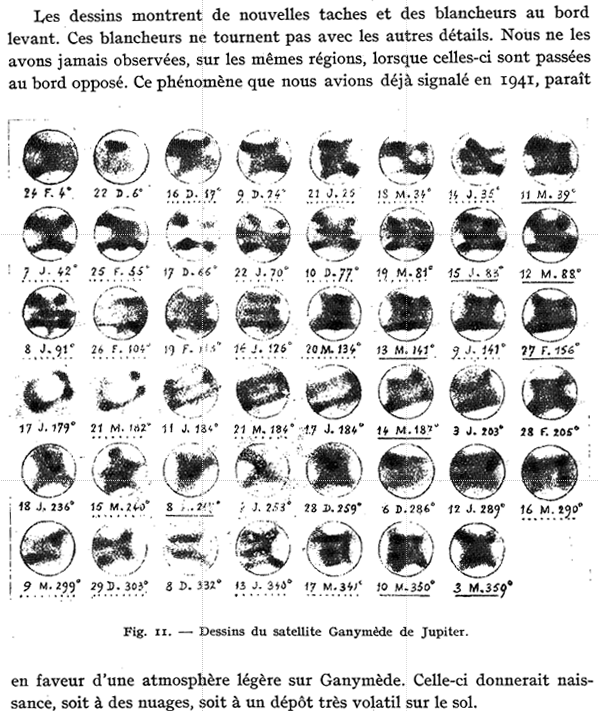Présentation de Ganymède
Ganymède est la plus grosse des lunes galiléennes de Jupiter avec Io, Europe et Callisto. Elle est même plus grosse que la planète Mercure et à peine plus petite que Mars. Ganymède est un monde constitué pour moitié d’eau, et pour l’autre moitié de silicates et de matière carbonée. Elle abrite sous sa croûte glacée le plus grand océan d’eau liquide du système solaire. Ganymède est un archétype des mondes glacés tels qu’on en trouve autour des planètes géantes de notre système solaire, mais aussi sans doute autour d’autres étoiles.
Sa surface présente des régions claires et jeunes, témoignant d’une importante activité passée, lors de laquelle des matériaux provenant de l’océan interne ont pu être remontés en surface. D’autres régions plus sombres et anciennes, comportent peut-être des matériaux datant de son accrétion et/ou des dépôts de poussières cométaires ou astéroïdales. Pour tenter de déchiffrer l’histoire de la surface de Ganymède, il faut donc identifier les constituants de ces différentes régions et comprendre comment ils se transforment sous l’effet des processus affectant sa surface.
Du givre matinal vu à la surface de Ganymède par le JWST ?
En août 2022, l’instrument NIRSpec (Near Infrared spectrograph, construit pour l’Agence Spatiale Européenne (ESA) par le consortium Astrium) du télescope spatial James Webb, a observé la lumière du soleil réfléchie par la surface de Ganymède dans les longueurs d’onde de l’infrarouge. L’une des images obtenues par le JWST/NIRSpec montre que sur la face arrière de Ganymède, les terrains sombres situés au bord du levant (c’est-à-dire là où le Soleil vient de se lever) sont recouverts de glace ayant une réflectivité particulière dans l’infrarouge : l’intensité des pics de Fresnel y est plus élevée que sur les autres terrains de la face arrière. Il pourrait s’agir d’un givre matinal, se sublimant au cours de la journée (voir https://ipag.osug.fr/french/actualites/faits-marquants/le-telescope-spatial-james-webb-observe-la-surface-glacee-de-ganymede.html)
Nos anciens avaient-ils déjà vu ce givre matinal ?
La disparition de givre matinal sur Ganymède avait déjà été proposée par les astronomes Henri Camichel, Marcel Gentili et Bernard Lyot suite à des observations depuis le Pic du Midi entre 1941 et 1945. Ces nouvelles données dans l’infrarouge semblent confirmer cette hypothèse. Le givre se formerait durant la nuit, non par condensation de l’atmosphère car elle est trop fine d’après nos connaissances actuelles, mais plutôt par condensation de la vapeur d’eau provenant du sous-sol, comme cela a été observé sur le noyau de la comète 67P/Churyumov-Gerasimenko par la mission Rosetta.
Camichel et al. rapportent « une vive blancheur sur le bord du levant » sur plusieurs observations de longitudes consécutives en 1941. (voir https://ui.adsabs.harvard.edu/abs/1943LAstr..57…49C)
Un phénomène curieux apparaît : pour tous les dessins de longitudes consécutives 312°,320°,342°, 343°, 3°, 11° et 19°, le bord droit, le levant, est occupé par une vive blancheur. Cette blancheur ne semble pas participer à la rotation, aucun dessin ne la montre à gauche ou au centre. Serait-ce un dépôt de matière trés volatile que le rayonnement solaire ferait disparaître ?
Puis Lyot confirme cela suite à de nouvelles observations, publiées en 1953, après sa mort (voir https://ui.adsabs.harvard.edu/abs/1953LAstr..67….3L)
Des observations importantes pour préparer la mission JUICE
Malgré les faibles températures qui y règnent, entre -180 et -110°C, et l’absence d’une atmosphère épaisse, les observations du télescope James Webb indiquent que la surface de Ganymède connaît peut-être des variations diurnes. Si la présence de givre matinal est confirmée, cela pourrait indiquer qu’il y a beaucoup plus d’eau sous forme gazeuse autour de Ganymède que ce qui a été précédemment estimé, ou bien que la surface de Ganymède est sujette à des phénomènes de sublimation et de recondensation d’eau, similaires à ceux observés sur la surface de la comète 67P/Churyumov-Gerasimenko (voir l’article de De Sanctis et al. 2015).
Ces informations contribueront à optimiser les opérations de la sonde spatiale JUICE de l’agence spatiale européenne (ESA), comportant plusieurs instruments sous la responsabilité du CNES. Lancée le 14 avril 2023, JUICE atteindra Jupiter en juillet 2031 et se placera en orbite autour de Ganymède en 2034 pour l’étudier de manière plus approfondie.
Appel à observations
Grâce à une campagne d’observation ciblée de la face arrière de Ganymède, nous espérons confirmer la présence de givre matinal sur Ganymède, et ainsi faire sortir de l’oubli cette connaissance qu’avait nos anciens, et qui sera très utile pour la préparation et l’interprétation des observations de la mission JUICE.
Protocole d’observation
Les amateurs produisent régulièrement des images de Ganymède montrant des détails de surface (par exemple Galileo Regio). Il s’agit ici d’observer Ganymède de préférence dans le visible (filtre luminance). Vu le diamètre apparent du satellite de moins de 2 secondes d’arc, un diamètre minimum de 250mm est requis pour avoir suffisamment de résolution. Il faudra imager Ganymède avec la même résolution que Jupiter seul. Une caméra couleur est utilisable, une monochrome est conseillée si on veut faire des images dans des différentes longueurs d’onde (R, V et B) ce qui permettrait de faire de la photométrie.
Le givre a été détecté par le JWST 1h30 (méridien central 270°) avant l’élongation maximale Est de Ganymède. Il vaut mieux observer Ganymède entre +/- un jour et demi autour de l’élongation maximale (méridien central entre 200 et 350° ; la période de révolution de Ganymède est de plus de 7 jours). Ganymède sera alors assez loin de Jupiter (jusqu’à 15 rayons joviens à l’élongation), il faudra donc pointer Jupiter puis déplacer le champ vers l’est dans la direction de l’équateur de la planète jusqu’à trouver le satellite à la bonne position.
Pour prévoir vos observations, vous pouvez consulter les éphémérides suivants (jusqu’à la fin de l’apparition de Jupiter en 2024-2025). La première colonne vous donne la date en TU, la seconde la visibilité depuis la France (‘*’ = jour, [C, N, A] = crépuscule, ‘ ‘= nuit), l’avant dernière colonne « ObsSub-LON » la longitude du méridien central, privilégiez donc quand elle est entre 200 et 350° pour bien observer la face arrière de Ganymède.
Inscription
Participer à ces observations vous intéresse ?
Envoyez vos observations de formations suspectes aux contacts ci-dessous
Contacts
Professionnel :
Olivier Poch – CNRS, IPAG, olivier.poch[at]univ-grenoble-alpes.fr
Amateur :
Marc Delcroix – commission des observations planétaires de la SAF, delcroix.marc[at]free.fr
Detection of morning frost on the Ganymede’s surface.
Presentation of Ganymede
Ganymede is the largest of Jupiter’s Galilean moons along with Io, Europa and Callisto. It is even larger than the planet Mercury and barely smaller than Mars. Ganymede is a world made up half of water, and the other half of silicates and carbonaceous matter. It shelters under its icy crust the largest ocean of liquid water in the solar system. Ganymede is an archetype of icy worlds such as those found around the giant planets of our solar system, but also undoubtedly around other stars.
Its surface presents light and young regions, testifying to significant past activity, during which materials from the internal ocean could have been brought to the surface. Other darker and older regions perhaps contain materials dating from its accretion and/or deposits of cometary or asteroidal dust. To try to decipher the history of Ganymede’s surface, we must therefore identify the constituents of these different regions and understand how they are transformed under the effect of the processes affecting its surface.
Morning frost seen on the surface of Ganymede by the JWST ?
In August 2022, the NIRSpec (Near Infrared Spectrograph, built for the European Space Agency (ESA) by the Astrium consortium) instrument of the James Webb Space Telescope, observed sunlight reflected from the surface of Ganymede in the lengths of infrared wave. One of the images obtained by JWST/NIRSpec shows that on the back side of Ganymede, the dark terrain located at the edge of the east (i.e. where the Sun has just risen) is covered with ice having a particular reflectivity in the infrared: the intensity of the Fresnel peaks is higher there than on the other areas of the rear face. It could be a morning frost, sublimating during the day (see https://ipag.osug.fr/french/actualites/faits-marquants/le-telescope-spatial-james-webb-observe- the-glaciated-surface-of-ganymede.html)
Had our elders already seen this morning frost?
The disappearance of morning frost on Ganymède had already been proposed by astronomers Henri Camichel, Marcel Gentili and Bernard Lyot following observations from the Pic du Midi between 1941 and 1945. These new infrared data seem to confirm this hypothesis. Frost would form during the night, not by condensation of the atmosphere because it is too thin according to our current knowledge, but rather by condensation of water vapor coming from the subsoil, as was observed on the nucleus of comet 67P/Churyumov-Gerasimenko by the Rosetta mission.
Camichel et al. reported « a bright whiteness on the edge of the east » on several consecutive observations of longitudes in 1941. (see https://ui.adsabs.harvard.edu/abs/1943LAstr..57…49C)
A curious phenomenon appears: for all the drawings of consecutive longitudes 312°, 320°, 342°, 343°, 3°, 11° and 19°, the right edge, the rising, is occupied by a bright whiteness. This whiteness does not seem to participate in the rotation, no drawing shows it on the left or in the center. Could it be a deposit of very volatile material that solar radiation would cause to disappear?
Then Lyot confirmed this following new observations, published in 1953, after his death.(see https://ui.adsabs.harvard.edu/abs/1953LAstr..67….3L)
Important observations to prepare for the JUICE mission
Despite the low temperatures there, between -180 and -110°C, and the absence of a thick atmosphere, observations from the James Webb telescope indicate that the surface of Ganymede may experience diurnal variations. If the presence of morning frost is confirmed, this could indicate that there is much more water in gaseous form around Ganymede than previously estimated, or that Ganymede’s surface is subject to sublimation phenomena and water recondensation, similar to those observed on the surface of comet 67P/Churyumov-Gerasimenko (see the article by De Sanctis et al. 2015).
This information will help optimize the operations of the European Space Agency (ESA) JUICE space probe, comprising several instruments under the responsibility of CNES. Launched on April 14, 2023, JUICE will reach Jupiter in July 2031 and will orbit Ganymede in 2034 to study it in more depth.
Call to observations
Thanks to a targeted observation campaign of the back side of Ganymede, we hope to confirm the presence of morning frost on Ganymede, and thus bring out of oblivion this knowledge that our elders had, and which will be very useful for the preparation and interpretation of JUICE mission observations.
Observation protocol
Amateurs regularly produce images of Ganymede showing surface details (e.g. Galileo Regio). This involves observing Ganymede preferably in the visible (luminance filter). Given the satellite’s apparent diameter of less than 2 arc seconds, a minimum diameter of 250mm is required to have sufficient resolution. It will be necessary to image Ganymede with the same resolution as Jupiter alone. A color camera can be used, a monochrome is recommended if you want to take images in different wavelengths (R, G and B) which would allow photometry.
The frost was detected by the JWST 1h30 (central meridian 270°) before the maximum eastern elongation of Ganymede. It is best to observe Ganymede between +/- a day and a half around maximum elongation (central meridian between 200 and 350°; Ganymede’s period of revolution is more than 7 days). Ganymede will then be quite far from Jupiter (up to 15 Jovian radii at elongation), it will therefore be necessary to point Jupiter then move the field eastwards in the direction of the planet’s equator until finding the satellite at the correct position.
To plan your observations, you can consult the following ephemeris (until the end of Jupiter’s appearance in 2024-2025). The first column gives you the date in TU, the second the visibility from France (‘*’ = day, [C, N, A] = dusk, ‘ ‘= night), the penultimate column « ObsSub-LON » the longitude of the central meridian, so choose when it is between 200 and 350° to properly observe the back side of Ganymede.
Registration
Are you interested in participating in these observations?
Send your observations of suspicious formations to the contacts below
Contacts
Professionnal :
Olivier Poch – CNRS, IPAG, olivier.poch[at]univ-grenoble-alpes.fr
Amateur :
Marc Delcroix – commission des observations planétaires de la SAF, delcroix.marc[at]free.fr






Commentaires récents